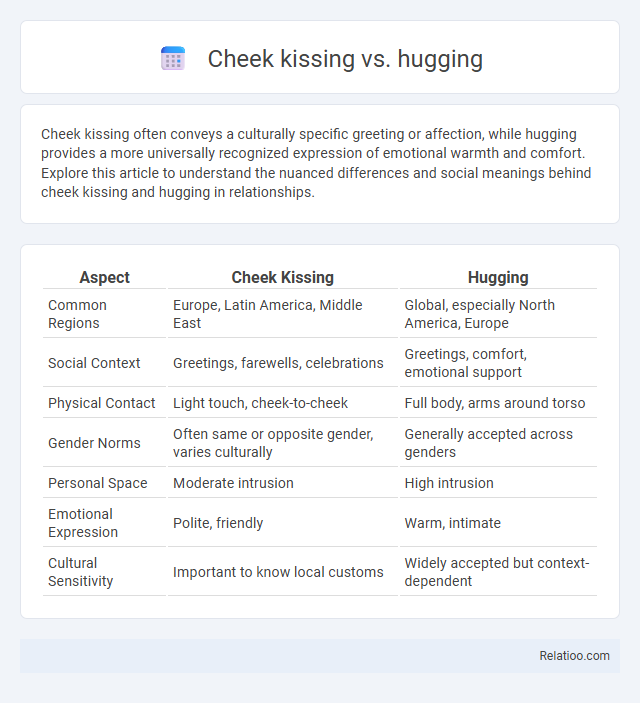Cheek kissing often conveys a culturally specific greeting or affection, while hugging provides a more universally recognized expression of emotional warmth and comfort. Explore this article to understand the nuanced differences and social meanings behind cheek kissing and hugging in relationships.
Table of Comparison
| Aspect | Cheek Kissing | Hugging |
|---|---|---|
| Common Regions | Europe, Latin America, Middle East | Global, especially North America, Europe |
| Social Context | Greetings, farewells, celebrations | Greetings, comfort, emotional support |
| Physical Contact | Light touch, cheek-to-cheek | Full body, arms around torso |
| Gender Norms | Often same or opposite gender, varies culturally | Generally accepted across genders |
| Personal Space | Moderate intrusion | High intrusion |
| Emotional Expression | Polite, friendly | Warm, intimate |
| Cultural Sensitivity | Important to know local customs | Widely accepted but context-dependent |
Introduction to Cheek Kissing and Hugging
Cheek kissing and hugging are common greeting rituals that convey warmth and social connection across cultures. Cheek kissing involves lightly touching or brushing cheeks, often paired with a kissing sound, symbolizing affection or respect in many European, Latin American, and Middle Eastern countries. Your choice between cheek kissing and hugging depends on cultural context, personal comfort, and the level of familiarity with the person you are greeting.
Cultural Significance of Cheek Kissing
Cheek kissing is a deeply rooted cultural greeting ritual in many countries, symbolizing warmth, respect, and social bonding. Unlike hugging, which often indicates comfort or affection, cheek kissing varies in execution and meaning across cultures, from two to four kisses exchanged depending on the region. Understanding the cultural significance of cheek kissing can enhance your social interactions and show respect for local customs when greeting others.
The Meaning Behind Hugs
Hugs convey a deep sense of warmth, comfort, and emotional connection, often symbolizing support and affection in social interactions. Unlike cheek kissing or formal greetings, hugging creates a physical bond that promotes oxytocin release, enhancing feelings of trust and security. Your choice to hug someone reflects genuine care and the desire to strengthen personal relationships beyond mere etiquette.
Cheek Kissing: Regional Variations
Cheek kissing as a greeting ritual varies significantly across regions, with Southern Europe, Latin America, and the Middle East exhibiting the most widespread and culturally ingrained practices. In France and Spain, two to three kisses on alternating cheeks are common, while in Latin American countries like Argentina, a single right cheek kiss often suffices. Contrastingly, Northern European and North American cultures generally favor handshakes or hugs, viewing cheek kissing as a more intimate or familial gesture.
Hugging: Universal Expressions and Differences
Hugging serves as a universal expression of warmth, comfort, and connection, transcending cultures while varying in duration, intensity, and social context. Your embrace can signify friendship, support, or romantic interest depending on cultural norms, where some societies use brief, light hugs and others prefer longer, tighter ones. Understanding these differences enhances your ability to communicate empathy and respect across diverse greeting rituals.
Nonverbal Communication: Cheek Kissing vs Hugging
Cheek kissing and hugging serve as powerful nonverbal communication cues, conveying warmth, affection, and social bonding in varying degrees across cultures. Cheek kissing often signifies a formal or casual greeting, commonly observed in European and Latin American societies, symbolizing respect and friendliness without physical intimacy. Hugging typically expresses deeper emotional connections, used among close friends and family to communicate comfort, support, and genuine affection beyond a simple salutation.
Emotional Impact: Cheek Kissing Compared to Hugging
Cheek kissing often conveys warmth and affection through physical closeness and cultural tradition, creating a subtle yet meaningful emotional connection. Hugging tends to produce a stronger release of oxytocin, enhancing feelings of comfort, security, and emotional bonding more intensely than a cheek kiss. Your choice between these greeting rituals can significantly affect the depth of emotional impact experienced during social interactions.
Situational Appropriateness: When to Kiss or Hug
Situational appropriateness in greeting rituals varies significantly across cultures and contexts; cheek kissing is commonly reserved for close friends, family, or romantic partners in many European and Latin American countries, emphasizing warmth and familiarity. Hugging serves as a more versatile gesture, acceptable among friends, family, and even colleagues in informal or emotionally charged situations, signaling support and affection. In professional or formal settings, a simple handshake or nod is often preferred over cheek kissing or hugging to maintain respectful boundaries and social decorum.
Social Etiquette: Cheek Kissing vs Hugging Rules
Cheek kissing and hugging vary significantly in social etiquette depending on cultural context; cheek kissing often serves as a formal or semi-formal greeting in many European and Latin American countries, while hugging is more common in informal or close personal interactions. Your awareness of local customs ensures respectful social engagement, as cheek kissing etiquette may require specific numbers of kisses or which cheek to offer first, unlike the more universally understood embrace. In professional or unfamiliar settings, modest physical contact like a handshake is typically preferred to avoid misunderstandings associated with cheek kissing or hugging rituals.
Choosing the Right Greeting: Factors to Consider
Choosing the right greeting depends on cultural context, personal comfort, and the relationship between individuals. While cheek kissing is common in European and Latin American cultures, hugging offers a universal sense of warmth and closeness, making it suitable for close friends or family. Your awareness of social norms and the setting ensures respectful and appropriate interactions that foster positive connections.

Infographic: Cheek Kissing vs Hugging
 relatioo.com
relatioo.com